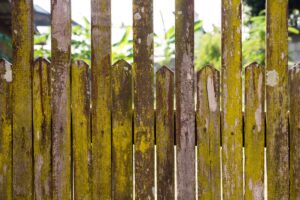Fence Maintenance Tips for Moisture and Mold
While we tend to spruce up our houses and interiors in spring, fence maintenance is an ongoing task that must be undertaken at various time of the year. That is if you want to ensure your fences last for as long as possible.
As we head towards another chilly winter, your fences will have to stand up to the challenges of cold, wet weather in the form of rain, snow and possibly hail. The weather itself isn’t the problem, as any Atlanta fence company will tell you. The problem is that these conditions impact in the form of moisture and mold that can quickly cause your fences to deteriorate.
Don’t delay: whatever type of fences you have in and around your property, check them out now for signs of damage.
Fence Damage to Check For

Now is the time to check for mold and mildew and to clean it off fences if need be.
Mold develops on most surfaces including vinyl, painted wood, and unpainted wood, and in different forms. There are a number of varieties that show up in different colors, some orange or yellow, some green, and the worst of all, black, which is allergenic and can even be toxic.
Mildew is a type of fungus caused by moisture, and it may look powdery or downy and feathery. Powdery mildew is usually white, but darkens to yellow or brown, and sometimes goes black. Downy mildew is usually yellow, turning brown over time.
Moisture damage often penetrates beyond the surface of fences, but it isn’t always immediately obvious. Check upright posts, particularly the bottom section of wood posts where moisture can cause the wood to rot. If the posts are unstable in any way, there’s a possibility that rot has already set in. Also check boards and rails for rot and splitting; even if there’s no rot they could be damaged or loose. If gates sag or don’t close properly, they too might have been adversely affected by moisture.
Also check the hinges and latches on gates to see if there are any signs of rust.
Dealing With Damage and Mold
Fence maintenance involves cleanup and fix up. The more diligent you are, the longer your fences will last, and the less time, effort and money you will need to spend on them.
Fence maintenance tips vary, depending on the kind of damage or deterioration you find.
Remove Mold and Mildew
If you spot mold early enough you can usually scrub it off quite easily. If water on its own doesn’t work, add a little dishwashing liquid to warm water, scrub and then rinse off thoroughly. If it is really ingrained, vinegar mixed with water can also do the trick, and so can bleach, but take care to avoid plants – you could kill them. Otherwise there are a number of proprietary solutions that are formulated to remove both mold and mildew; follow the manufacturer’s instructions. Whatever you use, be sure to remove the cleaner and mold or mildew residue with fresh, clean water.
Stubborn mold and mildew can also be removed with a pressure washer. Just be careful the pressure isn’t too high or you could damage the fence.
It is best to work on a sunny day so that the fence dries thoroughly, otherwise you’ll just encourage the cycle to start all over again.
Replace Damaged Parts of Fences
If there is any sign of damage or rot, replace the wood. If you’ve been conscientious about fence maintenance, you’re unlikely to have replace whole sections.
Posts can be detached from boards or rails and dug out of the ground. If the base was encased in concrete, it’ll be a bit more difficult, and you’ll likely need a pickaxe or a small jackhammer. Similarly, rails and boards can be detached from posts.
Protect Your Fences From Winter Moisture
Check painted and sealed surfaces to make sure they are sound. If paint has bubbled or is peeling, scrape down and repaint.
Wood that has been stained and/or sealed tends to darken as it absorbs moisture. Restaining and resealing will usually stop further absorption. Make sure the wood is totally dry before you stain or seal.
Rake autumn leaves and remove them so that they can’t collect moisture close to fencing when it rains or snows.
If you haven’t been fastidious about fence maintenance and there’s more moisture damage than you can deal with, FenceWorks of Georgia is an Atlanta fence company that can do the job for you. Contact us now to avoid further damage in the winter months.

